
|   |

|   |
 e-mail: leelakaverivenkat@gmail.com Kathak in varied manifestations September 13, 2023 It was a couple of weeks of Kathak and more of it in the capital! But contrary to the 'appetite getting sickened and dying' (to use Shakespeare's phrase from Twelfth Night) unexpectedly handsome turnouts for each event proved how new ideas have the power to stir jaded audience curiosity. The credit goes to young people, who, in a field so wedded to 'Khandaani' heritage, have boldly tethered Kathak grammar and body language to hitherto unexplored themes. 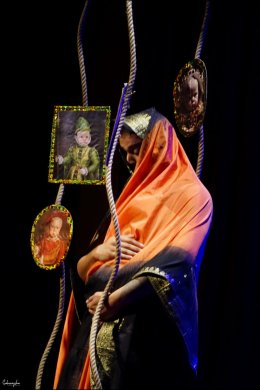
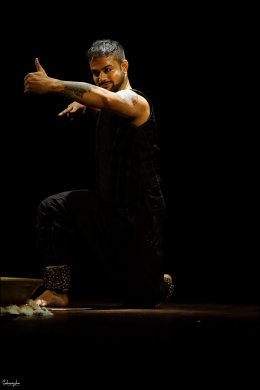
At Habitat's Stein auditorium, Kolkata based Kathak dancer Sudip Chakraborty and the Nirvana Arts Foundation presented 'Out Damned Spot,' an adaptation based on William Shakespeare's Macbeth. Well trained under Gurus Pranab Sanyal and Sandip Mallick, Sudip, an elegant performer, nurses a flair for subjects outside the traditional arena, expressed through the Kathak vocabulary. His latest endeavour in a dance/ theatre blend, seeks to focus on the driving force of ambition, which, when not tempered by sensitivity, can be a destructive energy. Without man's ever propelling urge to know and conquer, the world would have registered no progress. But ambition one knows has led to as many highs of achievement, as it has to troughs of destruction. Wisely, in choosing such a loaded theme as Macbeth, the dancer chose to keep both stage space and the aharya aspect plain and simple, enabling unhindered movement, and not taking attention away from the performance. With just two or three portraits, swaying, hung at different levels, strung on to two sets of strings, hanging from top to floor, at two diagonal ends of the stage, the dancer had the entire space of the stage for his actions. Language in this production, acts as just a propelling force, with no cultural identities attached, and quite cleverly the script by Sudip uses Hindi, bit of Shakespeare's quotes in English, Sanskrit and even Bengali - at various points - without action being ruptured by the feeling of an alien sound interfering. One must also acknowledge the choreography which brings into play at various points all ingredients of Kathak's body language - from chalis, chakkar, peir ka kaam, gat, even thata and of course language of bols. Music direction by Jaydeep Sinha with the voice over comprising Priyanka Guha and Jaydeep Sinha with Anik Sengupta on sarod and Mainak Mukherjee on violin and not the least, sensitive percussion on pakhawaj and percussion by Subhasish Sarkar, tabla by Amitangshu Brahma and Debojyoti Goswami provided an excellent backdrop for the enactment. And how soulful was the use of classical ragas - both Carnatic and Hindustani with Simhendramadhyamam and Revati of the former vintage while Misra Pilu, Pilu and Bairagi were from the latter heritage - with Kirawani in the celebration part, common to both musical genres. A compulsive communicator, Sudip's performance touched all the significant emotional highs of the play - A Kali Shloka start followed by a pregnant figure and lullaby came before the, so imagined, fulfillment of the prophecy, of Macduff being "untimely ripped from his mother's womb." Then followed the heinous act of murder followed by the premature celebration of Macbeth becoming Thane of Cawdar, before repentance and guilt take their toll, with the nightmare of sleep walking Lady Macbeth insanely engaged in a non-stop act of washing hands - to remove stains not 'all the perfumes of Arabia' can remove. Macbeth meets his end at the hands of fellow general Macduff in war- but not before he learns of his ambition ridden wife's death. Over repetitive performances, the work will acquire more streamlining. While success and failure are part of every stage venture, the significant aspect of the enterprise, for this writer, is the courage of conviction to explore new territory, and full marks for this! Parabola of Dance Similarly in a 'nothing venture nothing win' was the evening at Habitat, 'The Parabola of Dance' sponsored by Aditi Mangaldas' Drishtikon Dance Company on August 25, 2023. Unlike the circular path, the parabolic path presents new challenges, forcing the one who takes it to think in innovative ways. Started last year, this effort at helping young dancers present experimental work, always hamstrung by financial constraints and lack of sponsorship, is a worthy venture indeed. With about twenty minutes given to each performer, the interaction at the end with the audience asking questions and the dancers providing an insight into the creative process of each of the works presented, is perhaps the most valued part of the entire evening. 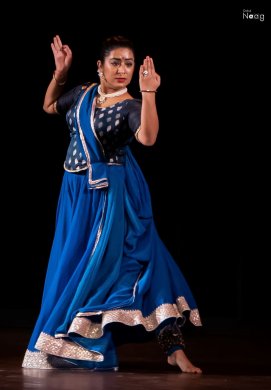 Aamrapali Bhandari (Photo: Rahul Naag) Trained under Pt.Rajendra Gangani at Kathak Kendra as a CCRT merit scholarship holder, and with a Masters in Kathak from Indira Kala Sangeet Vidyalaya, Khairagarh University, Aamrapali Bhandari who has travelled to several places and worked under many gurus like Kumudini Lakhia, Geetanjali Lal, Pt.Krishna Mohan Misra and several others, presented Shakti, with her guru for guidance and Gauri Diwakar as mentor. While based on the well- known mythology of the three goddesses Parvati, Durga and Kali, the work came across, for this writer, as a metaphor built round the concept of life's energy, and its dynamism, beyond gender and time - which makes the heart beat and the brain to think, and life to go on. What impressed one about the entire presentation was the way the dancer has worked on details of Kathak movement. One can discuss the broad lines of what a movement should be - but the micro details of body manipulation and its flow going into each movement, are something beyond description. And while Aamrapali's creation was so completely based on the grammar of Kathak, each fractional moment of a move, had amazing exactitude - that the dancer referred to when asked by the audience about how she perceived her choreography. She referred to perfection and more of it - and within that how the dancer detects, with ever increasing fluidity of body movement, travelling beyond the comfort zone, discovering new features emerging, and how movement seems to speak to one in ways hitherto not felt. Along with the competent music support in traditional style with Saptak Chatterjee providing vocal support, Saptak Sharma on the tabla also providing padhant, sarangi played by Mudassar and Anirudh Varma on keyboard, smooth movement continuity showed that the Kathak vocabulary can tell any story with panache - depending on how well versed with it the story teller is. 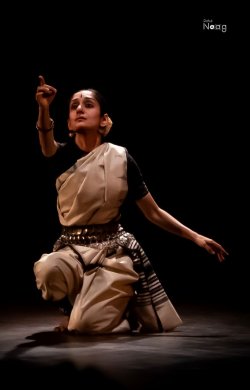 Arushi Mudgal (Photo: Rahul Naag) Arushi Mudgal, in the Odissi dance form, presented Sopaan, woven round the polarities of life - the outer and the inner, the transient and the eternal - underlining the journey of man with conflict flowing from the world of adornment spun by Maya, to the final realization of desiring less of everything, reaching the stillness and silence within. It is amazing how dance movement too opens out from a central point, travels through air, and finishes ultimately at the point from which it had taken off. Music as a strong inheritance of the Mudgal family plays a very significant role in Arushi's dance compositions. Madhup Mudgal's music composition in the classical mode, so vibrant in tone, in tunefulness and above all in its throbbing emotive power (with Sawani Mudgal also providing vocal support, Budhanath Swain on mardal, Kailash Sharma on flute, and Saeed Zafar on sitar) seemed to make the dance movements almost inevitable. With such a rock solid take-off point, the choreographer's burden becomes almost light - though one would not like to dilute and take away from Arushi's own creative imagination. Odissi movements at the start, along with the music, travelling gracefully, with hands spread through space seeming to be constantly reaching out, exploring and hungrily looking for that extra something, before realization sets in, and the nature of movement changes. The music hovering and ebbing round the lower notes suggesting looking for quietude and a resting place, seemed so potent for movements reaching inwards and looking for that silence. Altogether it was the chicken-and-egg story, where even after Arushi's reply to the querying, about discussing the idea of the theme first with her father before he composed the music, the dance/music effort, with minds working closely for so many years, seemed so entwined, that one could not decide what came first. 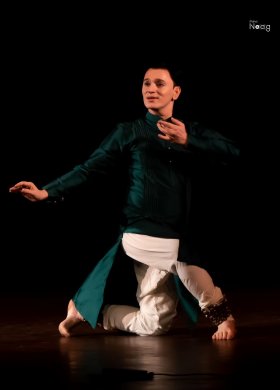 Dheerendra Tiwari (Photo: Rahul Naag) Dheerendra Tiwari, who had his Kathak training under Guru Pt. Rajendra Gangani at the Kathak Kendra, has been working for some years with Drishtikon Dance Foundation as a regular Repertory member and Rehearsal Director. Apart from his grasp over the classical idiom, he has emerged as one of the young dancers with a mind eager to experiment with new ideas. His presentation of Dui Pakhi was based on Guru Rabindranath Tagore's poem Khachaar pakhi chilo sonar khmaachatite, Boner pakhi chilo which was published in 1892, under the name of the person who had scored the notation (swaralipi), in Parjaay, natya geeti style in Teortala. The theme of Freedom and Constraints is expressed here through two birds - one soaring in the freedom of the forest, reaching for the skies, and the other sheltered (or held as one thinks) in the restricted space of a cage. The song of the forest bird is more lusty. But is its spirit of adventure, tinged with a desire for the peace and security of a protected environment? With mentoring under his guru Rajendra Gangani, Dheerendra Tiwari, post his very impressive performance, in his usual low-key style spoke of being rudderless at the start while planning his choreography - till the idea of Tagore's poem occurred to him, on suddenly remembering a past dialogue. "When I am not sure of complete freedom, how do I reflect the idea of complete freedom in my dance?" Speaking with great honesty, he replied that for him the in-between states are more true. Just as the ever adventurous person could go through bouts of longing for a quiet, custom-ridden, routine life in confined space, with life moving at an even pace, the one in a small area, may nurse a yearning for venturing into unnavigated territories - while ultimately realizing that life needs to be lived within confines of each person's capacities. How convincingly Dheerendra captured this feel in his dance with the Boner Pakshi admitting finally that remaining on ground is better for one who has not the capacity to fly (...mor shakti naehy uribar). And keeping the Tagore poem as the script, sung in the Tagore music style with Nishit Gangani on tabla, sarangi played by Mohammad Ayub Khan and with padhant and recitation of the poem by Bapi Dey, provided the right backdrop. The use of light in a minimalistic way also added to creating the atmosphere. Ventures of this type need to be encouraged by senior dancers, if any dance form has to keep pace with moving time. Kathak ki Kahani 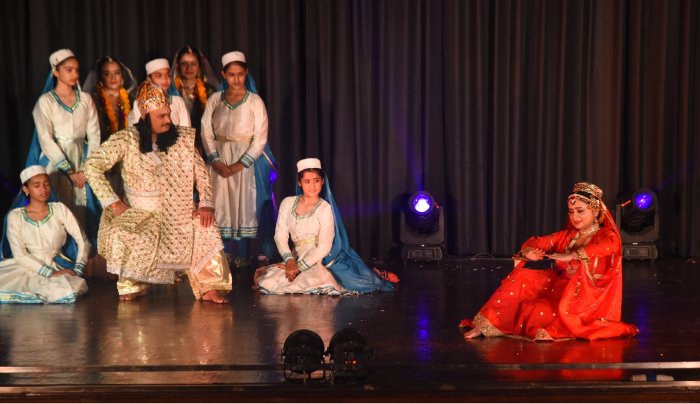 Uma Sharma's group In a very different mould was the evening at the India Islamic Centre, with Uma Sharma's Bharat Sangeet Sadan in collaboration with AKAM (Azadi ka Amrit Mahotsav, Ministry of Culture), presenting Kathak ki Kahani (Kathak Through the Ages). Built round the practice and movement of Kathak from Mandir to Court, to finally its present character in the contemporary proscenium space, the work was not so much a new production, as a cut and paste of sections, suiting the theme, from Uma Sharma's original productions. The entire treatment, in more ways than one, summed up in different ways, Uma Sharma's own career experience, with research into Raas Lila for years, studying poetry, music and temple dance in Brindavan and the areas nearby - alongside her training under Pt.Shambhu Maharaj - finally rounded off by years as a prime performer travelling all over India and abroad. From the nrittapradhaan Raas and Katha Vachan - inspired - Kathak stirred by intense devotional fervour, existing in and around the temples, to the dance in the Raj Durbars, with the added inspiration coming from the Mughal court under Wajid Ali Shah with the musical genre of the Thumri adding a special dimension to the art form, to the present manner in which Kathak is presented - a long period - was covered in a manner wherein involved passion in the presentation spoke more strongly than any glitter of virtuosity - making the entire production very communicative, posing no problems even for the uninitiated in the audience. Jatin Sharma as Kathavachak (narrator) appearing in-between scenes linked passages with information - his one error being a slightly premature appearance to introduce the Mughal Court and Wajid Ali Shah - when there were still some scenes to follow before that part. Kathak which was also known as Kushilava, with the popular saying Katha Kahe so Kathak kehlava, communities of Kathakas as rhapsodists, as reciters and narrators were seen in temples singing and dancing the glory of God. Devotional scenes with bhaktas singing and performing to lines like Din ayala...Kaushalya hit kari with Krishna lila scenes comprising the destruction of Pootana and the vanquishing of Kaliya, one was also treated to the refreshing sight of young children turned out as little gowals (cowherds) having a whale of a time, on and off the stage. Sri Krishna Ras Rupi of Brindavan with oft heard songs Sundara Gopalam and Nachat Hari Gopala, flashed in quick moving glimpses. Uma's presentation of Rasalila where the dancing is replete with Chakkars, Kavits and simple rhythm, concluding in the Raas' scene, along with the excellent costuming, has always had an authentic flair and with yearly presentations in Birla Mandir and other places at Janmashtami time, the dancers have a practiced ease with the form which makes itself felt at once.  Uma Sharma's group Bal Krishna scenes with little Krishna pleading maiya mein nahi makhan khayo with enactment spun round quick popular verses sung in every home, found an echo in every watcher's heart. The ta thai tat of Natwari Nritya vintage, followed by Wajid Ali Shah's contribution with scenes from Indra Sabha with snatches of Nachat mor sanga followed by snatches of Mujra (Sab kati taiyaar mujara karo) followed by Laal Pari (Din raat tujhako paane...) and Pukhraj Pari (gati hoon mein par nache sada kaam hai hamara), all ending with a Tarana - all aided by an intensely involved musical support made up the evening. The familiar faces of Madho Prasad providing vocal support, Mubarak Khan on tabla, Khalid Mustafa on sitar, Vinay Prasanna on flute have been with Uma's group for years. Ashok Parihar was on pakhawaj and Yograj Panwar provided padhant support and special effects. The new entrant was Snehlata Misra as the female vocalist. These old musician faithfuls, who as mentioned, have always been part of Uma's efforts, still contribute with highly involved performances, with a gusto, which, surprisingly, repetition over the years, does not seem to have dulled. As producer, seated on a chair at one side of the stage, it was a nostalgic experience for the elderly in the auditorium, to watch Uma Sharma, carried away by the music and theme, herself do Baitkar Bhav! Well trained, student dancers contributed involved performances - Anshupriya Bhatnagar as the main Krishna, Raghvendra Tiwari as Raja Indra, Sukriti as Radha and later as Pukhraj Pari, Nirmali as Yashoda and later as Laal Pari, Vani Bajaj as Putana, Kaliya and Krishna. Contributing to the uniformity of the corps de ballet were performers Meghna, Srishti, Anoushka, Kamakshi, Muskan, Gaurvani, Aanya, Navya, Tiyasha, Avni, Garima, Nikita, Vritti, Vaishnavi, Akshaini, Nettra and Nakshattra. Such shows can be taken to institutions to inform the general public about some aspects of the many influences which have made Kathak what it is today. From what the Chief guest admitted in his speech, even persons of his ilk, not to speak of the general public, know very little about our dance history. Epitome of Guru Bhakti in today's world 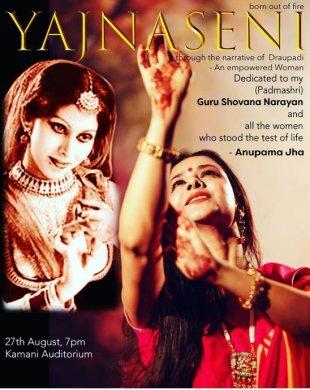 Yajnaseni Guru Bhakti in today's cynical world needs to be valued for its own sake. And it is in this department that Anupama Jha, a student of Shovana Narayan, seems second to none. Studying and staying abroad, with the Covid pandemic isolation also contributing to being away from India, meant her being taught mostly online by the Guru. Under the circumstances, the devotion to the physically absent Guru, seems all the more surprising. As a gesture of admiration for the Guru's persona and intense thankfulness to her, for not just the knowhow on dance, but all that it has signified to her in terms of understanding Indian culture in its totality, Anupama's thanksgiving gesture on August 27 was her production of Yajnaseni, a work built round the Draupadi narrative, highlighting empowered woman, presented at the Kamani. Dedicated to her guru Shovana Narayan and "all the women who stood the test of life" in like manner, the high profile evening dedicated to the Guru was a rare gesture indeed. That even the spacious interiors of Kamani auditorium could be filled also showed the respect and good feelings for Shovana in the general public. Aimed, to quote the publicity material, at 'building the dharma in the society and establishment of Bharatvarsha' the best part of the presentation woven round well known epic story of Draupadi and her travails leading to the Mahabharata war, was Pravesh Mallick's music composition and arrangement with lead singers in Sawani Mudgal and Pravesh Mallick. Anupama's concept, choreographed by Shovana with dancers from Asavari Repertory, had her dancing as Yagnaseni. Three years that she has spent learning a classical style, while encouraging, her training has a long way to go as yet. But more muscle to her Guru Pooja - the rest of the shishya world can certainly learn a thing or two from such exemplary devotion to the Guru.  Writing on the dance scene for the last forty years, Leela Venkataraman's incisive comments on performances of all dance forms, participation in dance discussions both in India and abroad, and as a regular contributor to Hindu Friday Review, journals like Sruti and Nartanam, makes her voice respected for its balanced critiquing. She is the author of several books like Indian Classical dance: Tradition in Transition, Classical Dance in India and Indian Classical dance: The Renaissance and Beyond. Post your comments Pl provide your name and email id along with your comment. All appropriate comments posted with name and email id in the blog will also be featured in the site. |